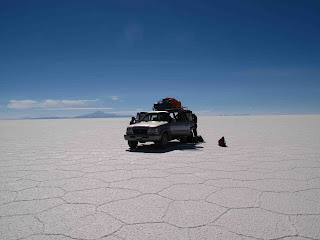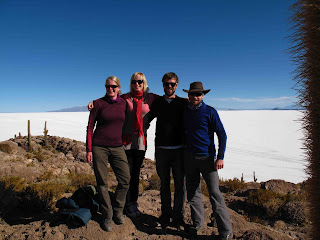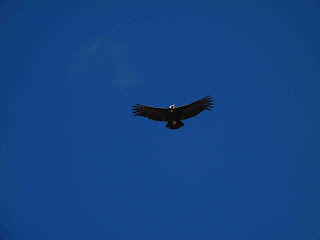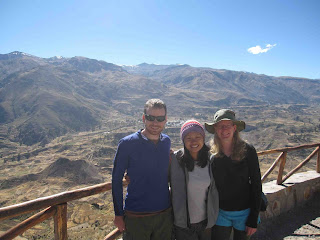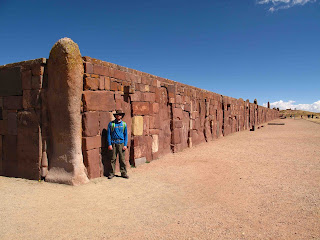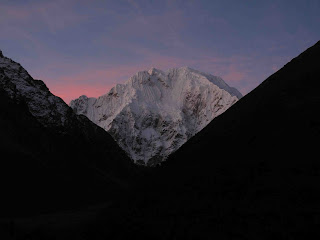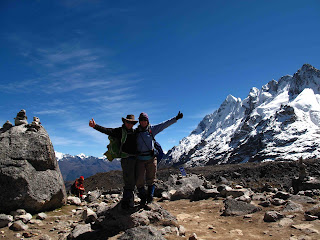We are now in Bariloche, in Argentina's lake district, following an 18 hour bus from Mendoza. At this stage 18 hours on a bus is usual and not the longest we have done, as will be explained below!
Two weeks ago we left Uyuni in Bolivia in an ageing but surprisingly comfortable Toyota Landcruiser with three Germans, a Spanish lady, and our driver Gregorio, a Bolivian who spoke no English. The first stop was at the Cementario de Trens, where a load of steam locomotives and carriages were dumped in the 1940's to slowly rust away, although some had been converted to swings, so weren't completely disused. From there we headed out onto the vast salt flats of the Salar de Uyuni, passing the ecologically disastrous salt hotels, which were being demolished. We stopped for lunch in the middle of the flats and attempted the customary perspectiveless photos, but failed completely despite having brought props including a bottle of Inca Kola. In the afternoon we stopped at a cactus-covered 'island' in the desert, where we once again met our friends Tina and Hamish, who we on the same tour with a different company. The day ended with a game of Inca chess in the hostel completely made of salt blocks and cactus wood, which sat on a hillside giving a spectacular view of the sunset and then sunrise over the Salar.
The second day of the tour began with Gregorio driving at great speed along the rough sandy road out of the salt basin. It then emerged that he had the ambition of competing in next year's Dakar Rally. This worried us a little, but he was actually a very good driver and probably could take part in the race and do well. The day was spent visiting a series of amazing lakes, with snowy volcanoes reflected in the water and flamingoes feeding by the shore. It was a great day, only dampened by the discovery that Sarah's bag had been partially soaked in petrol leaking from a container on the roof. The night was spent at about 4300m, the highest we have slept on this trip, and it was very cold outside but luckily warm inside as one of our sleeping bags was a petrol spillage casualty. We were given some truly awful Bolivian wine to accompany our dinner.
On day three it was supposed to be an early start but our car was blocked in by another which had a lost key followed by a flat tyre. We eventually got going, and Gregorio assured us that we wouldn't miss our connecting bus from the Chilean border, but we weren't convinced. We travelled past more colourful lakes and volcanoes, including some that we'd seen the other side of from Chile about a month previous. We reached the border at about 11am and were the second people to board the bus which then waited for others; Gregorio was right after all. The bus back to San Pedro de Atacama was along the smoothest tarmac we'd experienced for about four weeks, although it was rush hour at Chilean passport control so the journey slowed considerably.
Two days later we awoke in San Pedro and noticed it was cloudy. Alhough not normally a problem, cloudy in San Pedro means a blizzard at the 4200m Paso Jama, which our bus was due to cross to get to Salta in Argentina. Not only was the pass closed, but there was talk of it not opening for a week! We met a German girl who was planning to get the next bus to Santiago, so we decided to go with her and then cross Paso de los Libertadores to Mendoza the following day. The 23 hour bus journey to Santiago was surprisingly painless, mainly due to an accidental good choice in bus company. The next day we discovered that this pass was also closed, and it was only two days after that when we actually got a bus across. The bus passed hundreds of queuing trucks waiting to cross the border, went through a skifield, and then we were finally in Argentina!
First stop in Argentina on our hastily rearranged itinerary was Mendoza. It's a nice small city surrounded by vineyards. We did a Blenheim-style wine-and-bike tour of some of them. Most of the wines were of poor to moderate quality, but some were good, and all were better than Bolivian wine. We also found some good Patagonia beer to get us ready for the next stage of our journey. Someone has asked how much beer costs where we are, but in Argentina it's not easy to say, as the faltering economy means that a 20 peso bottle of beer could cost anything between US$2 and US$5, depending on which money changer you use.
So we are now in Bariloche. It's basically the Queenstown of Argentina, with a big lake surrounded by snow-capped mountains (but not quite snow-capped enough for the local ski resort which barely has any snow). It even has a gondola with a restaurant at the top, but also has a Swiss feel with log cabins, chocolate shops and St Bernard dogs. And everyone drives French or German cars. It's a beautiful place, and a great start to our Patagonian experience.
The train graveyard near Uyuni has been prepared for next year's event.
Our car at the lunch spot in the Salar de Uyuni.
With Tina and Hamish at Salar de Uyuni.
View of the salt flats from the island.
Sarah on the wind-carved rock formations on day 2 of the trip.
One of the lakes on the Salar de Uyuni trip.
Lake stop with flamingoes for lunch on day 2.
Paso de los Libertadores between Chile and Argentina.
Dave on one of the fine bicycles used for the Mendoza wine tour.
Sarah with a big wine barrel near Mendoza.

